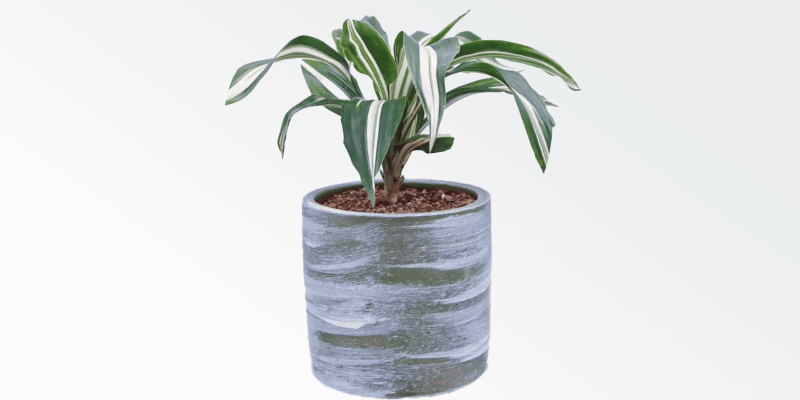Dracaena Fragrans (or the Corn Plant) is a fantastic airfiltering plant that makes it so easy to bring a palmy, tropical feelin’ into the home.
Corn plants are easy to care for, but there are two main issues to look out for when purchasing a new one.
We’ll cover those common issues, along with how to propagate Dracaena Fragrans, in our complete indoor care guide. Let’s get started!
Table of Contents
Corn Plant Care Guide
History, habitat, and characteristics
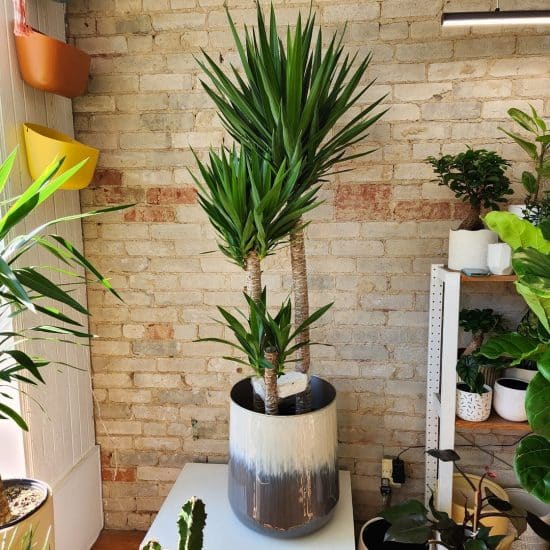
Corn Plant (Dracaena fragrans ‘Massangeana‘), is a popular evergreen species native to the humid African tropical rainforest region. Also called the Mass Cane, while it is considered a slow-growing perennial shrub in its natural habitat, it’s better known as an indoor plant due to its beauty and resilience. It has evolved to adopt an almost palm-like habit over time — tall, straight unbranched stems topped with minimal foliage resembling that of a cornstalk.
Dracaena fragrans is perhaps my favorite example of the Dracaena genus. In the wild, it can reach more than 25 feet tall (that’s one tall stalk), but indoors, it’s a bit more timid and can be easily cropped back while propagating to cultivate both a bushier or a tall, skinny look.
You may notice your stalk is green or doesn’t look like the brown stems featured in this article. That’s totally fine: you just don’t have a Corn plant! Many varieties of Dracaena feature a green stalk; they’re just separate species but with very similar care.
With most plants, we orient their placement around light and humidity, but the Corn Plant’s air filtering properties (highlighted by NASA research) are compelling enough that placement instead should be oriented around where you’ll be most in your house.
Whether that’s an office in your home, the bedroom, or a living room (just be careful of pets), your Corn Plant will happily go to work filtering that air and cheering up your home. Don’t worry, it’s very easy to care for.
Dracaena fragrans is named after the smell of its flowers, which can be quite strong. Whether you enjoy the aroma or not, you should definitely cut them off as soon as you notice a bloom because they are very nutritionally taxing on the plant. We’ll cover that in the planting and pruning section below.
Types of Corn Plant
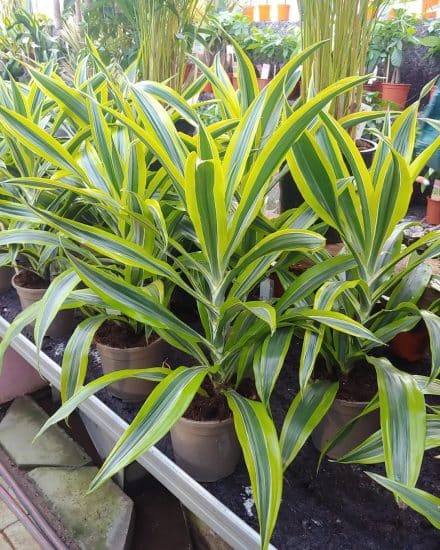
- Dracaena ‘Janet Craig’ – One of the most famous Dracaena, popular for its easy care and air filtration. One of the most common office plants you’ll see.
- Dracaena Fragrans ‘Lindenii’ – Green stem with yellow and green striping along its glossy leaves.
- Dracaena fragrans ‘Lemon Surprise’ – Bright yellow edges with green glossy centers. Leaves are a bit cupped and come to an angled and sassy point.
- Dracaena ‘Variegated Warneckii’ – A variegated Dracaena with deep green leaves featuring white stripes down the center. Tends to be bushier and shorter than other varieties.
- Dracaena ‘Limelight’ – A slow-grower with bright yellow-green leaves.
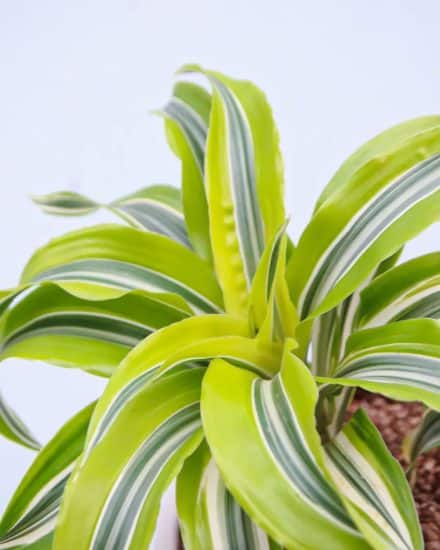
Dracaena Fragrans ‘Bausei’, if you see it, usually refers to just your regular ol’ Corn Plant.
Picking out a corn plant
If you have the luxury of picking out a Corn plant in person, there are a few things you need to check for. In order to save space while shipping, Dracaena are typically shipped out as just stacks of stems. These are then planted by growers. They root on one side and leaf on the other.
Why does this matter?
Depending on your garden center, these might not have mature root structures. So you need to check those roots! If you can, you’ll want to take a peek at the soil of your Corn Plant Dracaena before purchasing it; you’re looking to see that the soil is held together by a sprawling network of roots.
Also, pay attention to leaves. All of them should be a similar color, from the lowest ones on the stem to the young leaves at the top.
Light
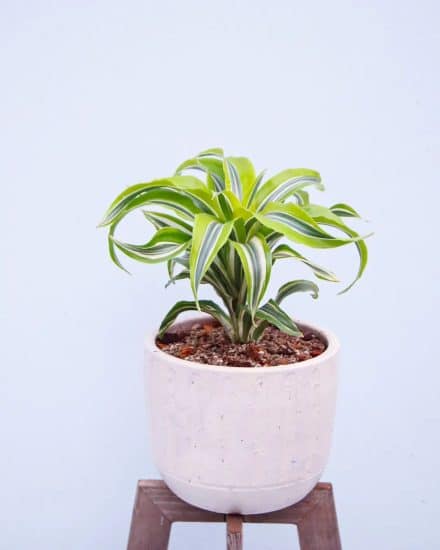
Finding a great location for your Dracaena fragrans often comes down to where the light is just right, but I’d also like for you to remember that this is an exceptional air-filtering plant. So consider placing it where you naturally spend a lot of time.
Dracaena corn plant doesn’t like a lot of sunlight. If placed in it, they’ll get burnt quickly as they become yellow-ish, to yellow, to all-brown… bye, Dracaena.
So consider an east or west-facing window, as this will give your plant some light in the morning or afternoon but not throughout the day like a southern exposure.
Water
Dracaena fragrans plants are especially sensitive to minerals in the water, but fortunately, the problem is super easy to diagnose.
You’ll want to look at the tips of your Corn plant: if you see brown leaf tips, then yellow, then green, this means there’s an issue with your water.
What happens is that minerals in the water are brought up by the roots, come through the plant, and then are excreted into the edges and tips to expel them. Here the plant sheds these cells, returning the minerals to the soil.
The solution is simple: cut the tips off as you see them, following the natural contour of the leaf. For your water: filter it or use rain/distilled water. You’ll notice an immediate improvement.
As far as water frequency, Dracaena plants are pretty forgiving and simple. Just feel the soil, and if it’s dry, give it a drink.
Temperature and humidity
The Dracaena Corn plant is extremely sensitive to cold temperatures, even for a tropical plant. Almost all Dracaena are this way, so you’re going to really need to baby this plant, especially during transportation.
That means warm up the car first, wrap your Corn plant in a blanket, whatever it takes to keep it cozy. It doesn’t manage sudden temperature changes well.
For regular care, normal household temperatures do just fine. Just be careful if you keep it by a window that you’re not letting in a cold draft. If you are, just shift your plant back a bit until the window is closed up again.
Humidity is a bit easier. You can spray the leaves (many people recommend it)., but it doesn’t do much more than clean them. For raising the humidity, it’s much better to buy a small humidifier, cluster your plants together, or set up a pebble tray with water.
Soil and planting
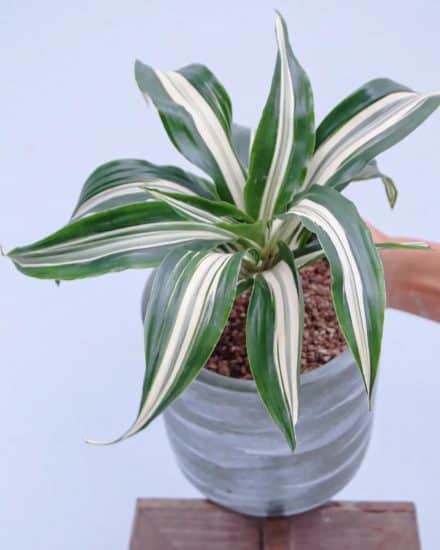
Dracaena fragrans does not like to stand in water; this pretty quickly destroys the plant. I recommend a soil mix of 70% potting soil, 30% perlite with decent drainage holes in your pot. The perlite will add water retention and aeration to your soil. You can avoid succulent soil, since your plant doesn’t need the excess sand.
Pruning Corn plants
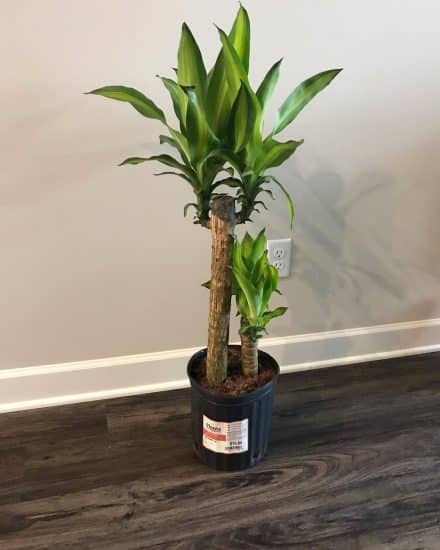
You’ll want to prune your corn plant stems as they become too tall. What do I mean?
If you let it, your Corn plant will happily grow all the way to the ceiling. To prune, you’ll want to make a cut from the top between two leaves. If you only have a stem, you can still prune it back, and you should see new buds appear if your humidity is high enough.
To maximize your chance of seeing new bud growth, you should prune in the early spring as the growing season begins. You’ll get more buds with fuller crowns. If you don’t, check humidity levels.
Your corn plant may flower — in fact, they are named after their fragrant white flowers (which are pretty strong). You’ll want to cut these off, even if you like the smell.
These flowers will sap your corn plant of energy and nutrients. Most plants don’t do well after full bloom, so just cut them off as they appear to save your plant.
Propagation guide
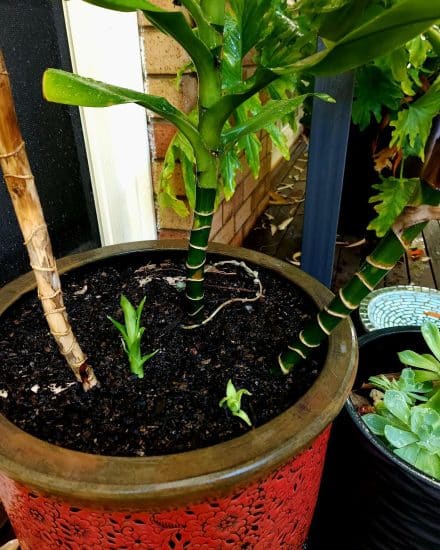
As these plants can grow pretty tall indoors, propagation provides a great way to shape your plant while making more for your friends. We’ll cover stem tip cuttings.
To propagate your Dracaena fragrans by stem cutting:
- Pick a stem that’s gotten too large and make a cut in between the leaves with sterilized shears. Cutting anywhere on the stem is fine — new stem buds will form from where you cut. Pick a section with healthy growth.
- Take the cutting and peel off the bottom leaves to reveal more stem, leaving a few at the top, then place the stem in a cup of water.
- Change the water every few days, leaving it in a location that gets plenty of indirect light. Once you see roots, it’s time to replant in its own pot or even return it to your original pot for a clustered look.
Honestly, you can just place this stem directly in soil too. I find that it works 90% of the time, or almost as often as water propagation. Give it a try, and if it doesn’t work, you’ll have enough growth soon that you can try by water next time.
Common issues
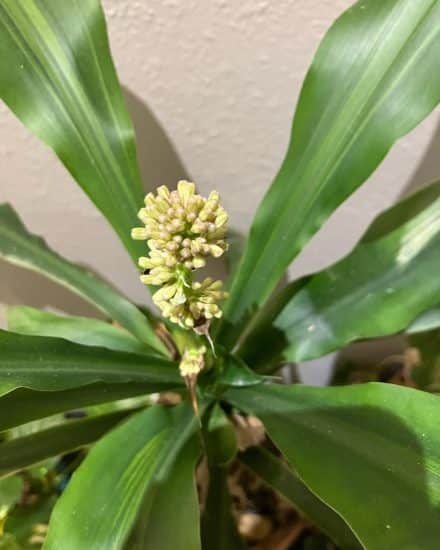
The lovely indoor corn plant is not without its issues, but almost all of these come down to one of the following causes:
- Too much plant food. Really, this plant doesn’t need too much fertilizer. If you do want to try it, use a balanced liquid fertilizer diluted to half strength twice a year in the growing season. You’ll notice crispy burnt leaf edges from the nitrogen if you use too much.
- Loss of leaves. This can often happen if you don’t cut off those fragrant flowers once they appear, from excess water or the plant sitting in standing water. You’ll want to check the drainage of the pot (make sure it isn’t clogged with roots) and that you are letting the soil dry out completely.
- Yellowing leaves. You want to pay attention to new growth on the top compared to the older growth, which is lower down on the stem. It should be green, lush, no brown tips or decay, and new leaves shouldn’t have a different shade than older leaves. If the shading is different, this indicates a problem with pests or roots. If all are discolored, it likely is an issue with the amount of water or light.
Depending on the variety of Dracaena fragrans you have, you might notice that some stems are green and others are brown and bark-colored. This isn’t a care issue, just something that varies with the type of Dracaena you have.
Diseases and pests
Corn plant’s leaves can attract fungus and pests, especially if the care is slightly off. If you leave the soil moist or expose the plant to sudden cold temperatures, this can invite some unwelcome guests.
Common pests include mealybug, scale insects, or spider mites. The solution is the same for any of them: remove the insects with a spray of cold water or a Q-tip dipped in alcohol. Treat the plant with neem oil and isolate it from your other plants. Make sure when isolating that you still give it enough light and water, because a lot of these pests are opportunistic and can thrive in low light or damage a plant that is receiving too much direct sunlight.
Root rot
If you notice your dark green leaves becoming yellow, especially with new growth, and your soil isn’t really drying out between watering, root rot is likely the cause. Unfortunately, it occurs all the time, and the fixes don’t work 100% of the time with a damaged plant.
That being said, you should repot the plant in fresh potting soil, checking its roots for any mushy, black parts. Cut them off and repot in fresh soil, adding plenty of perlite (30% or more is fine) to increase the drainage. When you water, really let the top few inches of this plant’s soil dry out completely.
Conclusion
Whether you know it as a Corn plant, Mass Cane, or just plain ol’ Dracaena fragrans, you’ve acquired a lovely and easy-to-care-for plant.
Best of all, this plant cares for you right back by filtering the air in your house. So if you have a new sofa or bed, cook a lot, or just live in a city, you’ll greatly appreciate the passive air filtration offered.
To avoid brown tips and other issues with this very popular houseplant, you should:
- Maintain humidity levels above 40% when possible.
- Give it filtered or distilled room temperature water. It’s very sensitive to minerals.
- Avoid too much sun (especially direct sun), but bright light is beneficial.
- Plant in well-draining soil with plenty of perlite.
Corn plants are like having a little palm tree in your home. I absolutely adore them and hope this care guide helped. If you have any questions we didn’t answer, please drop us a comment!
FAQ
What’s the difference between Corn Plant, Mass Cane plant, and Dracaena fragrans?
They’re actually all the same plant! Mass cane plant is also known as Dracaena Massangeana, and this guide will be perfect for any of the above.
Corn plants tend to be sold under a variety of names, mostly based on regional marketing or even variations in the cultivar. Most of these will have brown stems, unless they’re a related species, in which case you might notice a green stem.
Does a corn plant grow quickly?
They do grow tall, but growth can be a bit slow. This plant’s growth is influenced heavily by humidity, which allows its stems to create more nodes, which creates more leaves, which captures more light… you get it!
Does a corn plant tolerate direct sun?
Corn plants actually tolerate low light a lot better than any direct light. As the plant grows, it naturally provides itself more shade as leaves stack on top of leaves, so a mature plant can often tolerate a bit more light than new plants.

